Lesson 1
Introduction to macOS
Since its introduction in 2001, macOS (formerly known as Mac OS X or OS X) comes preinstalled on Mac computers. It offers the ease of use that the iPhone, iPad, Apple Watch, and Apple TV are famous for. macOS also provides an exceptional software development platform, with the result that a large selection of high-quality third-party software is available for macOS.
Reference 1.1
macOS Big Sur 11
macOS Big Sur 11 is the latest version of macOS. macOS combines a powerful open source UNIX foundation with a state-of-the-art user interface.
Integration Through Standards
Much of the success of macOS can be attributed to Apple embracing industry-standard formats and open source software. Adoption of common standards saves engineering time and allows for much smoother integration with other platforms. When Apple developers engineer a technology for a new feature, Apple often releases the technical specifications to the developer community. This fosters a new standard. An example of this is Bonjour network discovery, which Apple pioneered and has maintained as an industry-standard protocol commonly known as Multicast DNS (mDNS) for others to develop and use.
Another example is the Swift programming language for macOS, iOS, iPadOS, tvOS, watchOS, and beyond. After Apple unveiled Swift, it quickly became one of the fastest-growing languages in history. Swift makes it easy to write software that is incredibly fast and safe by design.
Here are some examples of common standards supported by macOS:
 Connectivity standards—Universal Serial Bus (USB), including USB-C, Thunderbolt, Bluetooth wireless, and the IEEE 802 family of Ethernet and Wi-Fi standards.
Connectivity standards—Universal Serial Bus (USB), including USB-C, Thunderbolt, Bluetooth wireless, and the IEEE 802 family of Ethernet and Wi-Fi standards. File-system standards—A file system determines how information, usually in the form of a file, is stored on and retrieved from a storage device. macOS supports file-system standards such as File Allocation Table (FAT), New Technology File System (NTFS), ISO 9660 optical disc standard, and the Universal Disk Format (UDF).
File-system standards—A file system determines how information, usually in the form of a file, is stored on and retrieved from a storage device. macOS supports file-system standards such as File Allocation Table (FAT), New Technology File System (NTFS), ISO 9660 optical disc standard, and the Universal Disk Format (UDF). Network standards—Dynamic Host Configuration Protocol (DHCP), Domain Name System (DNS), Secure Hypertext Transfer Protocol (HTTPS), Internet Message Access Protocol (IMAP), Simple Mail Transfer Protocol (SMTP), File Transfer Protocol (FTP), Web Distributed Access and Versioning (WebDAV), and Server Message Block/Common Internet File System (SMB/CIFS), including SMB3.
Network standards—Dynamic Host Configuration Protocol (DHCP), Domain Name System (DNS), Secure Hypertext Transfer Protocol (HTTPS), Internet Message Access Protocol (IMAP), Simple Mail Transfer Protocol (SMTP), File Transfer Protocol (FTP), Web Distributed Access and Versioning (WebDAV), and Server Message Block/Common Internet File System (SMB/CIFS), including SMB3. Document standards—ZIP file archives, Rich Text Format (RTF), Portable Document Format (PDF), Tagged Image File Format (TIFF), Joint Photographic Expert Group (JPEG), Portable Network Graphics (PNG), Advanced Audio Coding (AAC), the Moving Picture Experts Group (MPEG) family of media standards, High Efficiency Video Coding (HEVC, also known as H.265), and High Efficiency Image Format (HEIF, based on HEVC).
Document standards—ZIP file archives, Rich Text Format (RTF), Portable Document Format (PDF), Tagged Image File Format (TIFF), Joint Photographic Expert Group (JPEG), Portable Network Graphics (PNG), Advanced Audio Coding (AAC), the Moving Picture Experts Group (MPEG) family of media standards, High Efficiency Video Coding (HEVC, also known as H.265), and High Efficiency Image Format (HEIF, based on HEVC).
Reference 1.2
What’s New in macOS Big Sur
macOS Big Sur is the first macOS that runs on Mac computers with Apple silicon. In fact, Mac computers with Apple silicon require macOS Big Sur.
And, of course, macOS Big Sur runs on Intel-based Mac computers as well. As this guide goes to press, there are currently three models of Mac computers with Apple silicon, listed in Apple Support article HT211814, “Mac computers with Apple silicon” at support.apple.com/HT211814:
 MacBook Pro (13-inch, M1, 2020)
MacBook Pro (13-inch, M1, 2020) MacBook Air (M1, 2020)
MacBook Air (M1, 2020) Mac mini (M1, 2020)
Mac mini (M1, 2020)
Apart from the vast improvement in performance and battery life, users shouldn’t notice a difference between macOS Big Sur on a Mac with Apple silicon or on an Intel-based Mac most of the time. This guide addresses scenarios where behavior is different with a Mac with Apple silicon.
In addition to the features you can find in previous versions of macOS, macOS Big Sur includes hundreds of small improvements and a few significant new features. macOS Big Sur is the 16th major version of the Mac operating system since its initial release in 2001. Each release of the Mac operating system has a version number and associated name. Previously, each release used a version number that started with 10, like macOS Mojave 10.14 and macOS Catalina 10.15. macOS Big Sur is version 11. In this guide, older Mac operating system versions are called out with the version name, such as macOS Catalina.
The macOS Big Sur web page (www.apple.com/macos/big-sur) highlights the new features of macOS Big Sur with colorful interactive animations and demonstrations. Be sure to check it out.
Additionally, you can find an exhaustive list of new features in the article “New features coming with macOS Big Sur,” at www.apple.com/macos/big-sur/features.
Throughout, macOS Big Sur includes yet more privacy and security enhancements. Learn more in Lesson 9, “Manage Security and Privacy.”
The next several sections highlight some major features and improvements.
New Design for a Refined Experience
macOS Big Sur has a more cohesive look and feel throughout. New symbols are redesigned and common across controls, toolbars, and sidebars. This is true for macOS, built-in apps, and the apps you install. You’ll know exactly where to click.
macOS Big Sur helps you focus on your content. Apps are streamlined and more transparent. App sheets don’t have borders and bezels. The menu bar (at the top of your screen) is taller and more translucent, making more room for your desktop picture to shine. Menus are larger and have more space, improving legibility.
Windows have more room, making them easier to work with. They are more translucent. Edges are more rounded to match macOS. Sidebars extend to the full height of their windows, making it easier for you to find what you want. Toolbars have been redesigned. macOS Big Sur uses a new set of common symbols throughout macOS and your apps to represent common tasks. You’ll see these symbols in controls like toolbars, sidebars, navigation bars, context menus, and widgets. These new symbols add clarity and consistency, and they make it easy for you immediately recognize where to click.
The Dock now floats just above the bottom of your display. App icons are redesigned to feel both familiar and fresh; they have a uniform shape, making it easier for you to recognize at a glance.
System sounds are all new, but they sound familiar because they’re based on the originals. And the Mac startup chime is back!
New Control Center for Mac
Click Control Center ![]() in your menu bar to instantly access the controls you use the most, like Wi-Fi, Bluetooth, and AirDrop. Drag your favorite controls to the top of your menu bar for one-click access. Customize using Dock & Menu Bar preferences in System Preferences.
in your menu bar to instantly access the controls you use the most, like Wi-Fi, Bluetooth, and AirDrop. Drag your favorite controls to the top of your menu bar for one-click access. Customize using Dock & Menu Bar preferences in System Preferences.
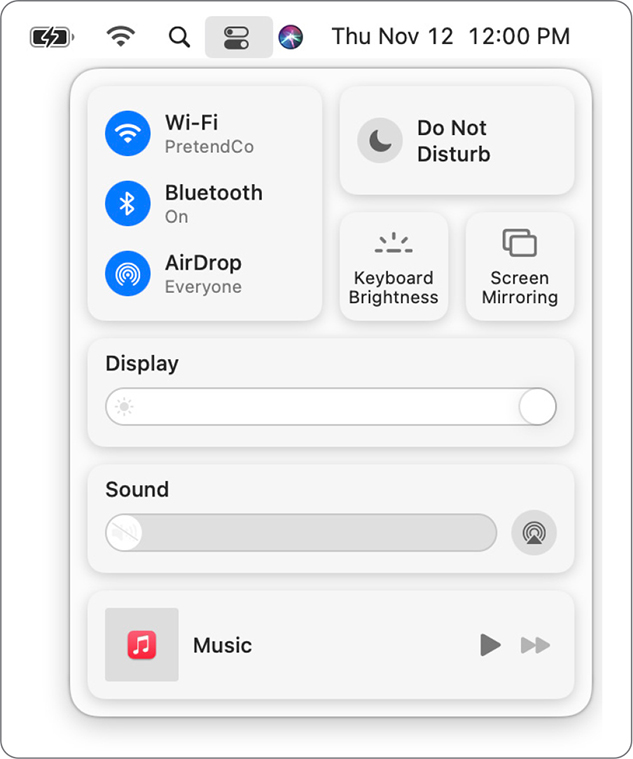
Note ![]()
To highlight specific features on the printed page, the reference portion of this guide uses an all-white desktop background for many figures. The exercises use different desktops to help differentiate between different users. We recommend you set your desktop background to an image or color that works great for you on your Mac.
Updated Notification Center
macOS Big Sur combines notifications and widgets in a single dedicated column. Notifications are grouped by app. Redesigned widgets come in three sizes. Just click the date or time to open Notification Center. Click Edit Widgets at the bottom of Notification Center to personalize your experience.
Biggest Safari Update Ever
Safari is vastly improved. There are more options than ever to customize your start page, like the ability to set a background image. At the same time, Safari now performs better and is more power efficient than ever. A new privacy report feature helps you understand just how often Safari prevents cross-site trackers from following you around on the web. Find out more about how Safari protects privacy and security in Lesson 9.
Improved Messages
Pin up to nine of your most important conversations to the top your list. And searching your past messages is easier than ever. Reply inline to a specific message in a conversation.
Redesigned Maps
Create Guides for your favorite places, or discover Guides created by brands you trust. Maps includes improvements for indoor maps, as well as new routes customized for the different needs of cycling and electric vehicles.
New App Store Privacy Information
A completely new section for each app in the App Store is dedicated to that app’s privacy practices. See Lesson 18, “Install Apps,” for more details on the App Store.
Time Machine Improvements
macOS Big Sur significantly improves Time Machine backup performance when you use a disk that’s formatted with Apple File System (APFS). See Lesson 17, “Manage Time Machine,” for more details on using Time Machine to back up your content.
Improved Accessibility Features
macOS Big Sur introduces features that make it even easier for everyone to control their Mac. Voice Control is just one example.
Voice Control
macOS Big Sur adds improvements to Voice Control, which was introduced with macOS Catalina. With Voice Control, users who don’t use traditional input devices can completely control their Apple devices just with their voice. Become more efficient with improved dictation and text editing features. Open and control almost any app by speaking.
After you enable Voice Control, your Mac completes a one-time download from Apple, and an onscreen microphone appears.
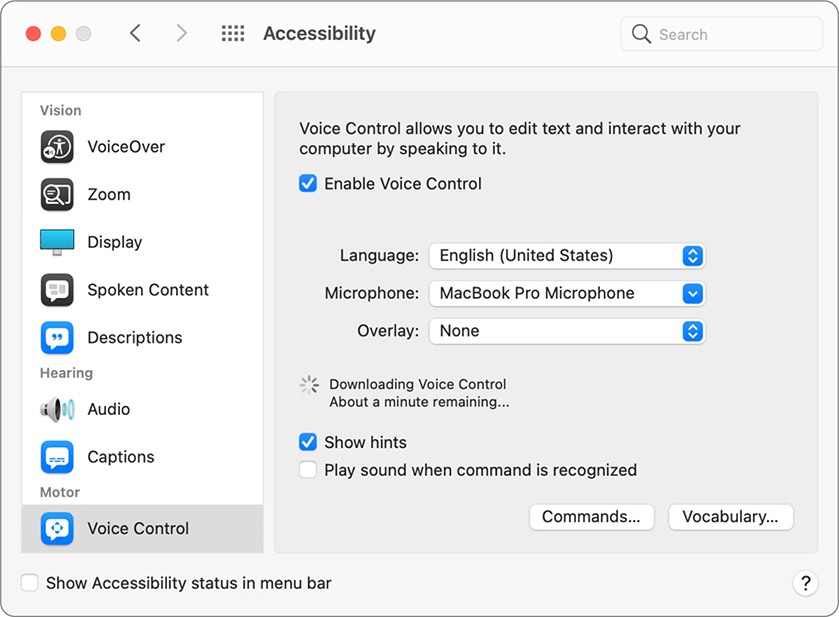
macOS Big Sur adds the Overlay menu to the Voice Control panel. You can choose the following:
 None (the default)—Don’t display any overlay until you say the command “Show numbers continuously” or “Show grid continuously.” If you say the command “Hide numbers” or “Hide grid,” this option is set to None.
None (the default)—Don’t display any overlay until you say the command “Show numbers continuously” or “Show grid continuously.” If you say the command “Hide numbers” or “Hide grid,” this option is set to None. Item Numbers—Always display item numbers that Voice Control recognizes as clickable, such as menus, checkboxes, and buttons displayed onscreen. Say the number of the item.
Item Numbers—Always display item numbers that Voice Control recognizes as clickable, such as menus, checkboxes, and buttons displayed onscreen. Say the number of the item. Numbered Grid—Always display a numbered grid that lets you select, zoom, and drag with verbal commands.
Numbered Grid—Always display a numbered grid that lets you select, zoom, and drag with verbal commands.
The following figure illustrates how Voice Control displays item numbers for the Overlay menu.

“Show hints” is a new option for Voice Control in macOS Big Sur. Select this option to display suggested commands and hints next to the onscreen microphone. In the following figure, the user said “Save” and Voice Control displayed the hint to try “Save document.”
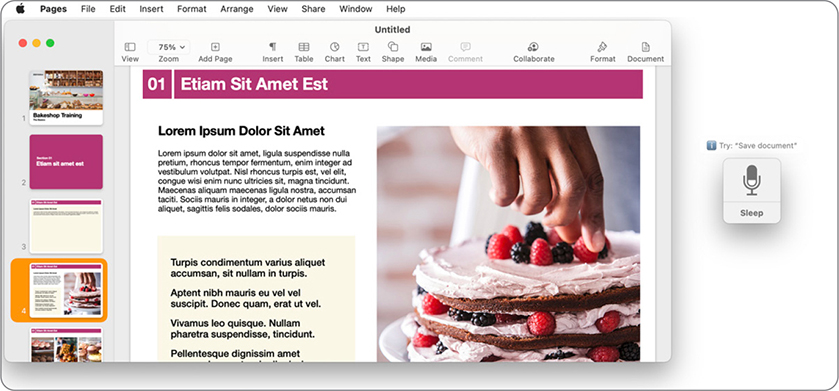
See “Change Voice Control preferences for accessibility on Mac” at support.apple.com/guide/mac-help/spc002 in the macOS User Guide for more information.
Photos Improvements
The list of improvements for Photos in macOS Big Sur includes:
 Expanded video editing capabilities
Expanded video editing capabilities Expanded photo editing capabilities
Expanded photo editing capabilities Improved Retouch tool
Improved Retouch tool Easy, fluid navigation
Easy, fluid navigation Captions (previously called descriptions)
Captions (previously called descriptions) Enhancements to Memories
Enhancements to Memories
Mac Catalyst Improvements
With macOS Catalina, Apple released the Mac Catalyst technology to enable developers to bring iPad apps to Mac. macOS Big Sur makes additional frameworks and application programming interfaces (APIs) available to developers, so it’s easier than ever to use the same code to build apps for multiple Apple platforms. And these apps will have a truly refined Mac experience when you run them on Mac. Apple now offers universal purchase for App Store apps. Developers can let customers purchase an app on one platform and have access to that app across macOS, iOS, iPadOS, tvOS, and watchOS devices.
Reference 1.3
Use macOS Help
macOS includes Help, which you can access from the Help menu or by clicking the Help button (it looks like a question mark) in a preference pane or dialog.
In the Finder or an app that has the Help menu, go to the menu bar, click the Help menu, and do one of the following:
 Enter a search term in the Search field, then choose from the Menu Items list or move the pointer over a menu item to reveal its location.
Enter a search term in the Search field, then choose from the Menu Items list or move the pointer over a menu item to reveal its location.
 Enter a search term in the Search field, then choose one of the Help Topics in the results.
Enter a search term in the Search field, then choose one of the Help Topics in the results.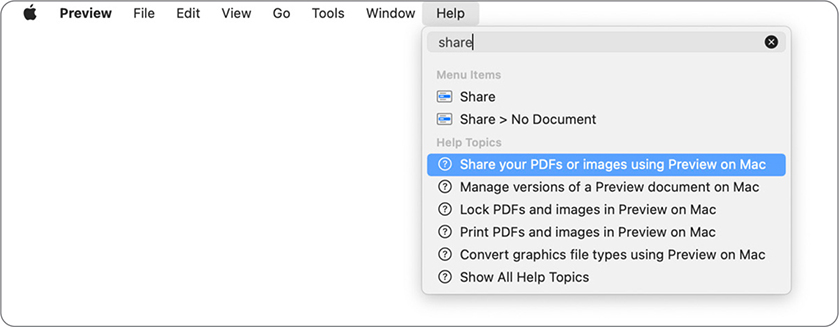
 Enter a search term in the Search field, then choose Show All Help Topics.
Enter a search term in the Search field, then choose Show All Help Topics.
 Leave the Search field blank and choose “app Help,” where app is the name of the app in the foreground, to open the User Guide for that app. If the Finder is the app in the foreground, choose macOS Help to open the macOS User Guide.
Leave the Search field blank and choose “app Help,” where app is the name of the app in the foreground, to open the User Guide for that app. If the Finder is the app in the foreground, choose macOS Help to open the macOS User Guide.
When you use the macOS User Guide or the User Guide for an app, the window stays visible on top of your desktop and all your other apps so that you can always see its contents. The following list includes some things you can do while using the macOS User Guide or the User Guide for an app:
 Drag the title bar to move the entire window.
Drag the title bar to move the entire window. Drag an edge or corner of the window to resize the window.
Drag an edge or corner of the window to resize the window. Enter a search term in the Search field.
Enter a search term in the Search field. Show the Previous (<) topic or Next (>) topic.
Show the Previous (<) topic or Next (>) topic. Click and hold the Previous button to see a list of previously viewed topics.
Click and hold the Previous button to see a list of previously viewed topics. Click the Table of Contents button beside the Next button to show or hide more topics.
Click the Table of Contents button beside the Next button to show or hide more topics. Click the Share button (it looks like a box with an arrow pointing up) to open the topic in Safari, print the topic, or choose other options.
Click the Share button (it looks like a box with an arrow pointing up) to open the topic in Safari, print the topic, or choose other options.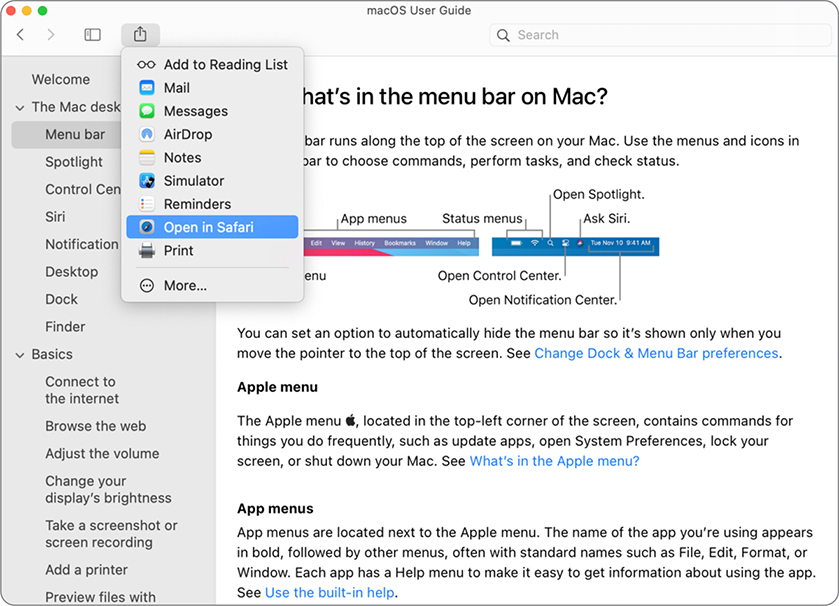
 Press Command-Plus (+) or make the text bigger or press Command-Minus (–) to make the text smaller.
Press Command-Plus (+) or make the text bigger or press Command-Minus (–) to make the text smaller. Press Command-F, then enter the text you want to find in the current topic.
Press Command-F, then enter the text you want to find in the current topic.
Most of the app user guides are available at a URL that has the pattern of support.apple.com/guide/app, where app is the name of the app.
See “Use built-in help on your Mac” at support.apple.com/guide/mac-help/hlpvw003 in the macOS User Guide for more information.
Reference 1.4
Review macOS History
The following table shows Mac operating system versions since OS X Mavericks 10.9, which is the earliest Mac operating system that you can directly upgrade to macOS Big Sur. See Apple Support article HT201260, “Find out which macOS your Mac is using,” for more information.
Name and version |
Release date |
Latest version |
Latest date |
|---|---|---|---|
OS X Mavericks 10.9 |
October 22, 2013 |
10.9.5 |
September 17, 2014 |
OS X Yosemite 10.10 |
October 16, 2014 |
10.10.5 |
August 13, 2015 |
OS X El Capitan 10.11 |
September 30, 2015 |
10.11.6 |
July 18, 2016 |
macOS Sierra 10.12 |
September 20, 2016 |
10.12.6 |
July 19, 2017 |
macOS High Sierra 10.13 |
September 25, 2017 |
10.13.6 |
August 28, 2018 |
macOS Mojave 10.14 |
September 24, 2018 |
10.14.6 |
July 22, 2019 |
macOS Catalina 10.15 |
October 7, 2019 |
10.15.7 |
September 24, 2020 |
macOS Big Sur 11 |
November 12, 2020 |
11.1 |
December 14, 2020 |
